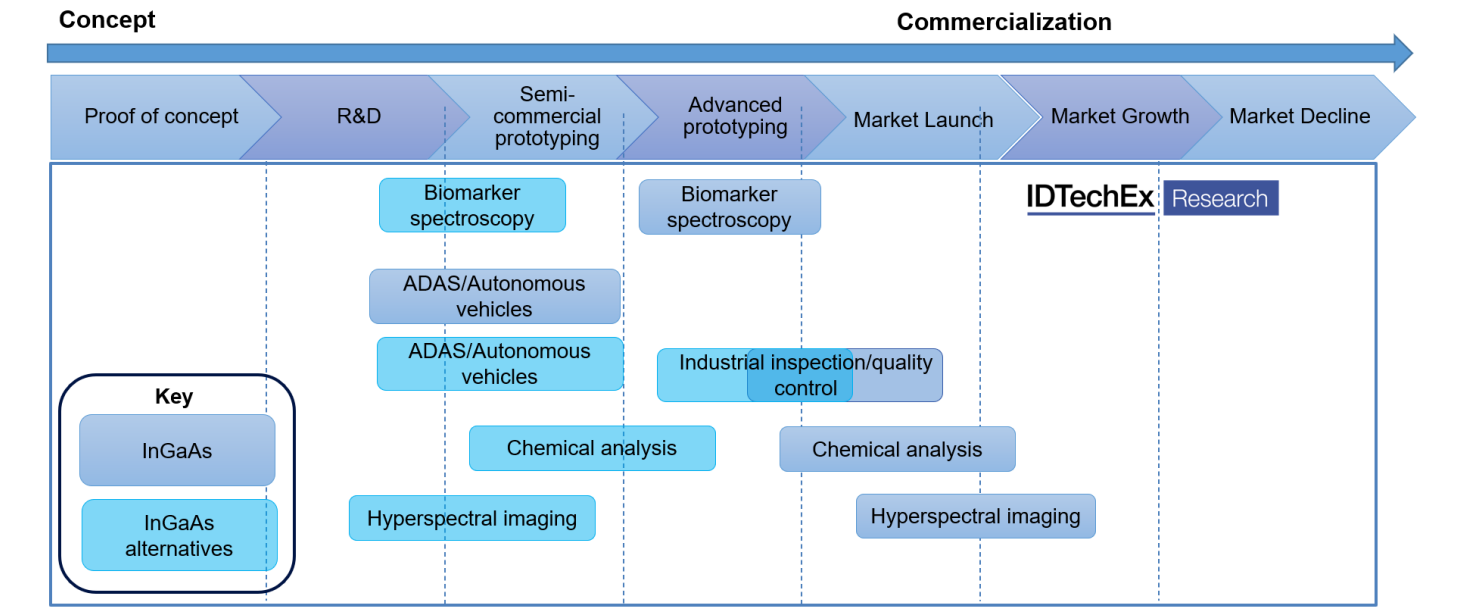Helping to make autonomous vehicles safe with cameras designed for low visibility or ensuring the best crop quality for farmers are just two benefits of short-wave infra-red (SWIR) sensing technologies and highlights their high versatility. SWIR sensors and hyperspectral imaging are two of the largest types of emerging image sensors, and IDTechEx predicts the market value will reach US$739 million by 2034, highlighting just how valuable the technology will be.
Autonomous Vehicles and SWIR
ADAS (advanced driver assistance systems) and autonomous vehicles use SWIR sensors to see in low visibility conditions such as fog or dust and uses light in ‘eye-blind’ regions to illuminate objects without affecting human vision. Object classification done by SWIR sensors can identify specific objects in the road, from animals to obstructions. This technology can also distinguish liquid water from ice on the road, allowing the vehicle to notify the driver of an impending hazard.
Quality Control
SWIR sensors are in demand largely due to their versatility, which provides value across many sectors. Quality control and foreign material detection in food are another use case for SWIR sensors. They identify the difference between similar-looking materials like salt and sugar and even foreign objects like stone and metal that could contaminate produce. Quality control also extends to detecting counterfeit bank notes, showing up characteristics of real money by distinguishing its more complex layers.
InGaAs vs Alternatives: Commercialization Status of SWIR Sensors
Due to its sensitivity and range capabilities, InGaAs (indium gallium arsenide) semiconductor technology has been vital for the development of SWIR sensors. However, InGaAs can lack the resolution to make it suitable for wider applications, which is why cheaper alternatives are sought. The most promising strategy is to increase the sensitivity of silicon to long wavelengths by printing a layer of quantum dots or organic semiconductors onto silicon read-out circuits. Relative to InGaAs, this approach could be over 100x cheaper to manufacture since existing readout electronics can be used.
InGaAs has been developed over many years, so it is likely to remain in use for some time for high-end applications. IDTechEx’s report, “Emerging Image Sensor Technologies 2024-2034: Applications and Markets”, explores more of these future, more cost-effective alternatives that will open up high-volume applications.

Application readiness level of SWIR detectors. Source IDTechEx
Hyperspectral Imaging
Hyperspectral image sensors can detect many different EM bands returning a subject’s spectral fingerprints that are undetectable to the naked eye. This spectral information will be different for different chemicals, providing an easy way for a computer to tell the difference between, for example, a plastic that can be recycled and one that can’t.
Food freshness can also be determined using hyperspectral imaging. Produce such as fish and other raw meats that might not always look bad at first could actually be hiding not-so-healthy germs. Hyperspectral imaging technology could show up textures and colors associated with a lack of freshness and could potentially help establishments avoid customer complaints.
Farmers can benefit from hyperspectral imaging in crop production. Using the technology from a bird' s-eye view could aid the early detection of weeds and assess moisture levels showing up in different patterns and colors, helping farmers predict the quality levels of the crops. Due to this technology’s detailed and thorough capabilities, it has great potential to grow across many different sectors.
Combining Emerging Imaging Technologies
Emerging image sensors have the potential to improve the quality of products and produce across all sectors so drivers can feel safer and chefs can be assured their food is fresh. Looking further into the future, development is underway, combining hyperspectral and SWIR technologies. This could offer a cheaper alternative to current methods of hyperspectral imaging with similar performance levels, opening up doors for new innovations and opportunities in different sectors.
For more information and examples of emerging sensor technologies, see IDTechEx’s report on the topic, “Emerging Image Sensor Technologies 2024-2034: Applications and Markets”. Find out more about this report, including downloadable sample pages, by visiting www.IDTechEx.com/ImageSensors.
For the full portfolio of sensors market research available from IDTechEx, please see www.IDTechEx.com/Research/Sensors.





